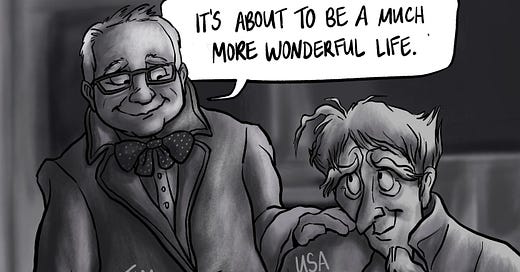New political cartoon! + preview discussion: What should a political cartoon be?
Taking the conversation out of Facebook comment sections
New political cartoon for
out this week!My accompanying blurb as published:
“Kamala Harris has picked well: With his dad jokes, sense of right and wrong, record on helping feed children, and empathy for people across backgrounds, Tim Walz sure seems like the angelic, comforting figure that America needs right now. Clarence the Angel from It’s a Wonderful Life would be proud.”
At the start, I was a little bit concerned about the viability of this idea. I, perhaps unfortunately, have come to believe that cartoons that are positive as opposed to critical automatically have to make up progress in the memorability and excellence department.
But this cartoon has gotten the best response of my four cartoons so far for Counterpoint, this one included, on Facebook and Twitter, by a long shot. Huge thanks to all who liked or reposted it.
I was, of course, inspired by Clarence the Angel from It’s a Wonderful Life. While I expected that to be the reason this cartoon would flail, it seems to have been key to its success, as I’ll explain:
It seemed like a major reason this cartoon was so popular is that it referenced a movie beloved by a largely older demographic, which I think is the same demographic that is the primary audience of political cartoons.
That brings me to a discussion I’ve been having with other cartoonists and cartoon enjoyers on Facebook. I recently saw a video made by one of my favorite YouTubers criticizing numerous recent pro-Kamala Harris cartoons that raised some questions that have long been on my mind about political cartooning as a medium:
Who are political cartoons actually for? Who reads them? Do they make a difference?
How funny do political cartoons need to be when they are trying to be funny? (The last part of that is crucial. Political cartoons absolutely do not have to be funny to be good.)
What does a good political cartoon achieve? How do you make one interesting?
Is it helpful to criticize cartoons that, while you may agree with the politics of, you may find “cringe?” Especially during the current political climate?
How do we evaluate humor that is made for audiences we may not be a part of?
Have political cartoons that have tried to be funny historically tended to fail?
And the big one on my mind that I’ll admit is a question at the core of my thoughts here:
Have I currently settled on political cartooning as my humor medium of choice because I’m not as funny as I’d like to be?
I think honesty in writing this Substack is good.
I’ve already started writing this essay because of all the Facebook posting and commenting I was doing: the essay will be what I’ve already posted plus plenty of elaboration on points that, if you’re on Facebook, you’ve already seen both me and about 20 other commenters dig into. I’m very excited to get into this.
More soon.







I'm looking forward to sampling whatever you serve up.